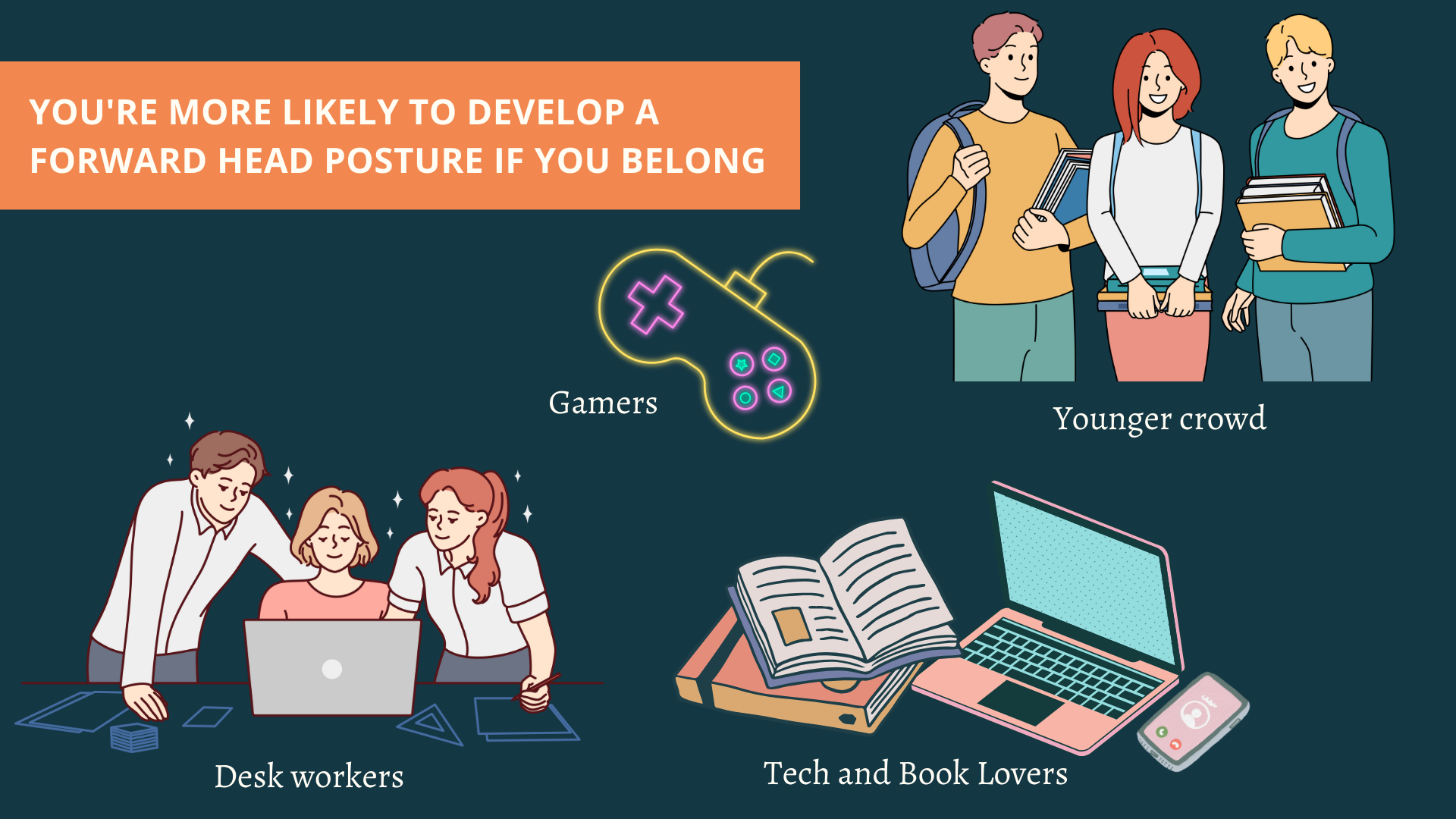Have you noticed that your head is leaning forward too much lately?
You’re not alone.
Numerous people deal with forward head posture—a consistent source of annoying aches and pains.
But here’s the good news: chiropractic care offers a real solution!
In this article, we’ll dive into how Dr. Doerr addresses forward head posture and will help you stand tall again!
What Is Forward Head Posture?
You’re sitting at your desk, looking down at your phone or computer for hours. Without realizing it, your head inches forward. This repeated motion, day after day, will leave you with a specific type of poor posture, where your head sticks out in front of your body. That’s what we call “forward head posture.”
Forward head posture puts extra weight and strain on your neck and upper back, causing discomfort and future spine and muscle issues.
4 Causes of Forward Head Posture

Excessive Computer Screen Time
When looking at a computer screen, especially one not at eye level, you end up leaning forward without even noticing. Over time, the leaning motion stresses your neck and back muscles as they support your head’s extra weight.
Too Much Driving
When driving, especially for long periods, there’s a good chance you’re leaning slightly forward to see the road better or to reach the pedals and steering wheel comfortably.
But this repeated movement will shift your head forward from its ideal position over the shoulders.
Now, the body is pretty adaptable. Your body will settle into this new alignment if you’re constantly leaning forward while driving. And just like that, you could find yourself with a forward head posture even when you’re not at the wheel.
Carrying a Heavy Backpack
When carrying a heavy load on your back, your body will try to balance itself by leaning forward. Your head must shift forward to compensate for this forward lean. This is your body’s way of keeping you from toppling over.
Over time, if you’re always sporting a backpack on your shoulders, your head may settle into this forward spot even when you’re not carrying anything.
That’s when forward head posture occurs.
Rounding of the Spinal Column (Kyphosis)
Kyphosis is a spinal condition that describes an exaggerated curve in the upper part of your back, making it look hunched or rounded.
When your upper back starts to round more than it should, your head and neck jut forward to keep things balanced. Dealing with a rounded upper back and a forward head may lead to neck pain, migraines, and muscle overexertion.
4 Forward Head Posture Symptoms

First up, we’ve got intense pain. When your head is constantly forward, it puts a lot of extra strain on the neck and upper back muscles.
Next, there’s soreness—like when you’ve carried a super heavy backpack for too long, and your shoulders start feeling it. That’s what the muscles in your neck and shoulders feel like—constantly sore, constantly reminding you they’re unhappy.
Then, we’ve got fatigue. Your neck and back muscles are exhausted from working extra hard to keep that forward head in place.
Last but not least: headaches. The forward head posture stresses out your muscles, leading to tension headaches and making it almost impossible to focus on anything else.
How Does Forward Head Posture Affect the Spine?

Forward head posture isn’t just about looking a little funny; it can actually do a number on your spine.
The spine isn’t just one long bone; it’s a series of smaller bones stacked together.
The upper part of your spine, right at the back of your neck, is called the “upper C spine.” When your head tilts forward, this part of the spine feels the pressure. It’s like if you held a heavy book way out in front of yourself—your arms would get tired pretty fast.
Now, let’s move to the “lower C spine.” This part of your spine also responds to the pressure of the forward head posture by keeping your head balanced.
Finally, there’s the “thoracic spine“—the part of the spine in your upper back. With the head pushing forward and the upper and lower C spines doing their best to keep things balanced, the thoracic spine can get pulled and strained, too. It leads to even more pain, and because it’s connected to your ribs, it will make proper breathing harder.
On top of all this, the forward head position causes fatigue. Your muscles are working extra hard to keep things in place—it’s like running a marathon without a finish line in sight!
Am I Likely to Develop a Forward Head Posture?

First up, desk workers! If you spend hours at a computer, hunched over, tapping away at those keys, you might be leaning your head forward without even realizing it.
Now, what about the younger crowd? Hauling around heavy backpacks full of books will make you lean slightly forward to balance the weight.
Gamers and tech lovers are up next. If you’re deep into a video game or endlessly scrolling on your phone or tablet, your head will end up tilting forward. It’s easy to lose track of time and posture when caught up in the digital world.
Lastly, we can’t forget book lovers. Diving into a riveting story for hours will make you forget all about sitting up straight.
Which Muscles Are Affected by Forward Head Posture?

When your head leans forward a lot, specific muscles work overtime, and some get plain lazy, especially around the neck area:
- The suboccipital muscles (the tiny muscles at the base of your skull) are the primary muscle group feeling the brunt of the work. When your head pushes forward, they tighten up and work overtime to hold it up—a lot of heavy lifting for such small muscles!
- The sternocleidomastoid and scalene muscles (on the side and front of your neck) are tiny helpers balancing everything when your head leans forward. But instead of helping, they add to the problem when tense.
- The upper trapezius and levator scapulae (the muscles on the back of your neck and upper back) get pulled too much because of the forward position of the head.
- The deep cervical flexors (the muscles deep inside the neck) don’t get the workout they need when your head tilts forward all the time. So, they end up becoming weak neck muscles.
6 Side Effects of Forward Head Posture

While forward head posture might seem trivial, it will lead to a domino effect of not-so-fun side effects:
- Extra pressure on the neck and spine: Every inch of your head moving forward adds 10 extra pounds of weight to your neck—like carrying around a bowling ball all day!
- Pain in the neck and upper back
- Tension headaches
- Muscle overstretching and tightness: When muscles are unhappy, they cause pain, soreness, and fatigue.
- Improper jaw alignment and breathing issues: When your head tilts forward, it strains your jaw joint, leading to jaw pain and popping sounds when you open and close your mouth. And because your head tilts forward, it might be harder for you to breathe deeply since your chest and lungs don’t have enough space to expand.
- Poor aesthetic: A forward head posture will make you look like you’re slouching all the time, even if the rest of your body is standing tall.
Will Chiropractic Care Address My Forward Head Posture?

You’ve probably seen someone, or maybe even caught yourself, with the head jutting forward while walking, sitting, or even standing. Forward head posture is a common alignment issue, but the encouraging news is that chiropractic care offers a whole toolbox of methods to help you stand tall and proud—without that forward head lean!
First up, we’ve got spinal manipulation. This is what many patients think of when they hear “chiropractic adjustment.” It’s where a chiropractor uses their hands or an instrument to apply controlled force to a spinal joint. The goal is to improve the movement and position of your spine, thus helping pull your head back into a more natural position.
Next on the list are posture correction exercises for your neck and back. A chiropractor will show you specific exercises to strengthen all the weak muscles and stretch out the tight ones.
Then, there’s soft tissue therapy. This collection of chiropractic treatment techniques is all about massaging and working on the muscles and ligaments around your neck and spine. Getting these areas to relax lowers pain and improves your posture.
Kinesio taping involves applying special tape to support your muscles and joints, guiding them correctly. It’s like having a little posture coach stuck to your back, reminding you to sit or stand up straight.
Lastly, we have heat and cold therapy. It uses warmth or coldness to treat pain and swelling. Your chiropractor will suggest using a warm towel or an ice pack on your neck or back to help soothe discomfort.
3 DIY Remedies for Forward Head Posture

First, let’s talk about your workspace.
If you’re spending a lot of time on a computer or at a desk, you want everything to be just right.
This is where ergonomic adjustments come in:
- Adjust your computer screen so it’s at eye level.
- Keep your feet flat on the floor with your knees at a 90-degree angle.
Now, about bedtime.
The pillow you use can make a huge difference.
Consider changing your sleeping pillow to one that supports your neck but doesn’t prop your head up too much. It’s all about finding that Goldilocks spot—not too flat, not too puffy, just right.
Finally, let’s tackle your backpack situation.
Carrying a heavy bag around all day, especially on one shoulder, can throw your balance off.
Instead of using a single-strap bag, switch to a two-strap backpack. This adjustment will help distribute the weight evenly on both shoulders. Also, make sure you’re not stuffing it too much. A heavy bag will pull you backward, causing you to lean your head forward to compensate.
Discover the Benefits of Practicing Good Posture with Dr. Doerr!
At Bergen Chiropractic and Sports Rehabilitation Center, our chiropractic team, under the leadership of Dr. Gregory Doerr, adheres to the highest medical standards to provide superior chiropractic help. Our mission is to provide unparalleled patient care in a comfortable, healing atmosphere.
Access our contact form or call us at (201) 945-4075 to learn more about our chiropractic care services! Our offices at 532 Anderson Avenue, Cliffside Park, NJ 07010, and 62 Summit Ave, Hackensack, NJ 07601, are ready to welcome you as we proudly serve the areas of New York, New Jersey, Philadelphia, PA, and Baltimore, MD. Also, access our blog, Facebook, and Instagram pages for more information on ways to correct forward head posture!
References
- “6 Symptoms Forward Head Posture How Chiropractic Helps.” New You Chiropractic, 25 July 2023, newyouchiropractic.com.au/blog/forward-head-posture/. Accessed 25 Oct. 2023.
- Benevida. “The Best Ways to Fix Forward Head Posture (Nerd Neck).” Benevida Health & Wellness Center – Kyle & Buda Texas, 5 Aug. 2023, www.benevidawellness.com/how-to-fix-forward-head-posture/. Accessed 25 Oct. 2023.
- “Correcting Forward Head Posture with Chiropractic Care.” Accident Care Chiropractic Chiropractor, 7 Aug. 2023, accidentcarechiropractic.com/correcting-forward-head-posture-with-chiropractic-care/. Accessed 25 Oct. 2023.
- “Everything You Need to Know about Forward Head Posture: Symptoms, Treatment, and How Chiropractors Help.” Https://Www.Renew-Chiropractic.Com/, www.renew-chiropractic.com/everything-you-need-to-know-about-forward-head-posture-symptoms-treatment-and-how-chiropractors-help/. Accessed 25 Oct. 2023.
- “Forward Head Posture: Can Chiropractic Care Help?” Awaken Chiropractic & Sports Medicine, Awaken Chiropractic & Sports Medicine, 7 Jan. 2022, awakenchiroco.com/forward-head-posture-can-chiropractic-care-help/. Accessed 25 Oct. 2023.
- “Forward Head Posture: How Chiropractic Care Helps You Look up and Feel Better! – Re:Chiropractic.” Singapore Pain Solutions, 1 Oct. 2023, www.sgpainsolutions.com/general-health-tips/forward-head-posture/. Accessed 25 Oct. 2023.








